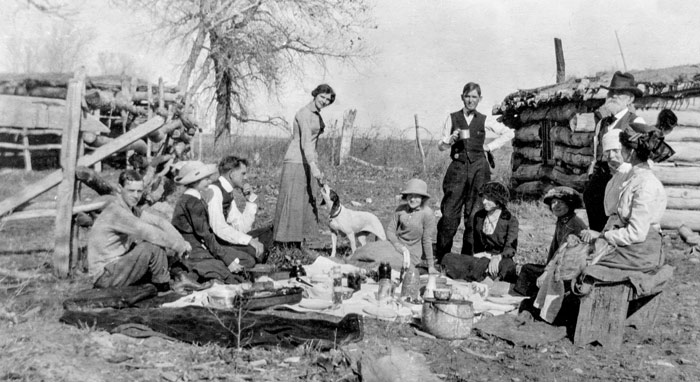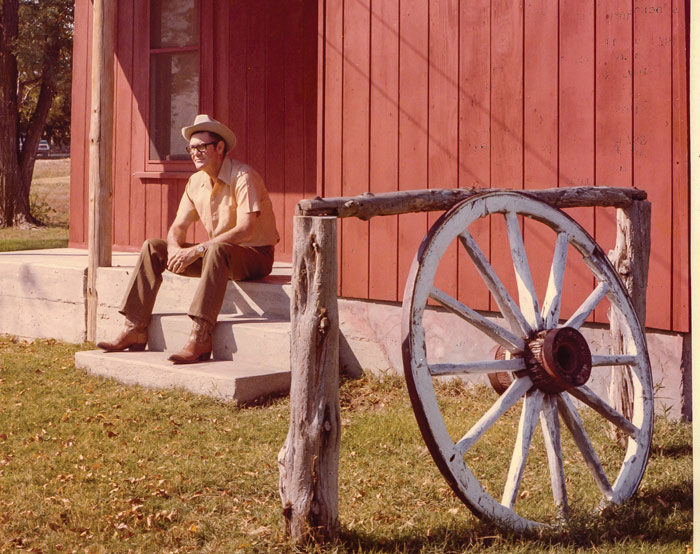
The Todd family enjoys a Sunday afternoon picnic at their ranch near Canadian, Texas, ca. 1917. Among the picnickers are Bill Nix’s great-uncle Jep Todd, standing at center, and great-grandmother Laura Todd, far right, who together would pen a letter 17 years later describing ranching conditions during the Depression.
Growing up during the 1950s drought in Hemphill County in the northern Texas Panhandle, William D. “Bill” Nix Jr. learned early on not to complain about tough times on the family ranch.
"If I complained, Dad would just tell me to go read the letter that my great-uncle wrote in 1934,” he says.
The two-page typed letter — written by his great-grandmother and great-uncle to their Production Credit Association (PCA) — described even tougher times during the Depression. In lengthy detail, it pleaded their case for borrowing an extra $100 a month to operate their 12,000-acre ranch plus 3,000 acres belonging to relatives, and care for 1,400 head of cattle.
Evidently, says Bill, his ancestors received the funds they requested, and that’s why his father, William D. “Dale” Nix Sr., dedicated many years of his life to Farm Credit, beginning as a PCA employee in the late ’30s and culminating as chairman of the Federal Farm Credit Board in 1981 and 1982.

Dale Nix in front of the 100-year-old Nix Ranch bunkhouse, ca. 1985, and as chairman of the Federal Farm Credit Board, 1981-82
Photos courtesy of Nix Ranch
“I think it goes back to understanding the experiences that his uncle and grandparents endured,” says Bill. “I believe he saw the Farm Credit System as saving American agriculture at a time when farmers and ranchers had nowhere to turn. The family had been blessed for so many years by the Farm Credit System, and it was his way of giving back.”
A Borrower at Age 10
Bill’s own loyalty to Farm Credit was forged in 1951 when he took out his first PCA loan at the age of 10.
“I was in the fifth grade, and I wanted to buy some club calves, so Dad took me down to fill out a PCA loan application — and I was scared to death,” he says, admitting that he was unaware that his father had already cosigned the loan.
“That secret [that he’d cosigned] stayed with Dad and Erbin Crowell for many years,” he says. Crowell, the longtime president of Canadian PCA, returned to Canadian, Texas, after retiring as vice president of the Federal Intermediate Credit Bank (FICB) of Houston. Dale died in 2000.

Bill and Puddin Nix
Although young Bill lost $300 a head on the five steers that he purchased, owing to the plunging market that resulted from drought, the PCA made him another loan, and he learned an expensive lesson about risk and the value of an understanding lender.
Two years ago, he reluctantly paid off his last loan with the same association, now known as Capital Farm Credit.
“It was a very sad day,” says Bill. “I was actually tempted to keep a loan just to maintain my Farm Credit membership.”
A Family Tradition
Bill’s father was a Farm Credit borrower for nearly 60 years, and his great-grandmother and great-uncle, who raised his dad, did business with Farm Credit for many years as well. The tradition continues with a fifth generation, his son, Todd Nix, who is currently a Capital Farm Credit customer.
Today, Nix Ranch is owned by a limited family partnership. Bill and his wife, Puddin, live on the property, located north of Canadian, and he has continued to oversee the cow-calf and stocker operation since retiring from the Episcopal ministry 12 years ago. Bill recognizes, however, that without Farm Credit’s help, his family and others might have different ranching legacies to pass down to future generations.
“I tend to agree with my dad’s assessment — we likely would not have weathered the ’30s and ’50s without the Farm Credit System,” Bill says. “I’m not sure how much land would still be in the ownership of families.”
– Staff
1934 Letter to Lender Details Ag Conditions
For 82 years, the Canadian, Texas, branch office of Capital Farm Credit has retained a letter that speaks volumes about the economy and agricultural conditions in West Texas during the Great Depression.
Dated Sept. 29, 1934, the two-page, single-spaced letter was written by W.J. “Jep” Todd Jr. and his mother, Laura Todd — great-uncle and great-grandmother of Bill Nix — to the PCA.
Apparently, the FICB had turned down the Todds’ loan request for extra funds to cover living and operating expenses. As the following excerpts reveal, the letter explained why the family needed $250 monthly, not $150, to operate the sprawling Todd Ranch, now the Nix Ranch.
“We have already cut our living expenses right down [to] the minimum. . . . We never buy any meat of any kind and our grocery bill during these summer months for the entire outfit, town, ranch and all, has not averaged $20 per month,” the Todds wrote to the lender, which had advised cutting household expenses.
Windmills Costly But Necessary
Their largest ranch operating expense was the upkeep of their 12 windmills — $171 during the previous five months.
“The other day when we counted our cattle, we had 772 cows and 618 calves and they have all summered fat, but they would not have had water or any calves to speak of if I had been running the ranch on $150 per month,” the letter stated. “I have one windmill that needs a new tower now, another needs the wheel repaired, but as I did not have but the $150, I was unable to repair them this past month.”
In addition, the Todds farmed about 400 acres, and their largest farming bill was for gas and oil for their Farmall tractor, which they also used to pump water, grind feed and cut hay.
“I think that next year I will try to use horses and mules, but as high as grain is right now, doubt if that will cut down much,” the Todds wrote. “We have cut our labor bill to a minimum. The highest priced man I have is married and he and his wife are working for $30 per month. We keep three men when we are farming and try to get by with two as much as we can.”
The letter continued: “I do know that if I can get the necessary expenses to take care of the situation, that the cattle, if there is anything like the anticipated recovery in values, will within the next 12 to 24 months put this loan in a much stronger position.”
$8,745 Loan for Six Months
The letter ended by asking the PCA to advance the family $8,745 to cover the following expenses for six months: $5,400 for feed, $475 for their land lease, $1,500 for living and operating expenses, $100 for salt, $20 for vaccine, $900 for their Federal Land Bank payment and $350 for their commissioner’s loan — a refinancing loan extended by the Land Bank commissioner under the Emergency Farm Mortgage Act of 1933.
The Todds’ descendants believe that the loan request was granted.